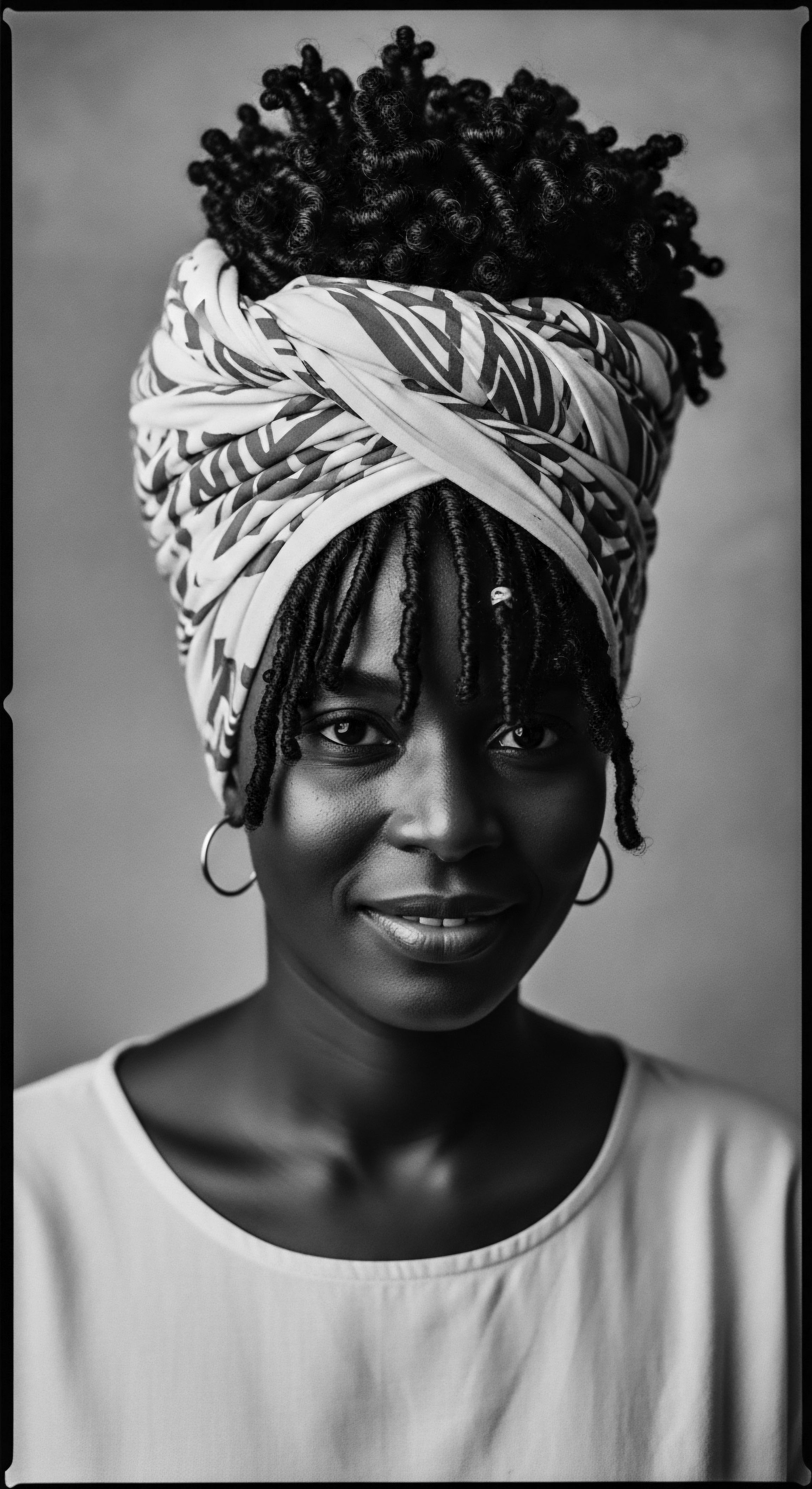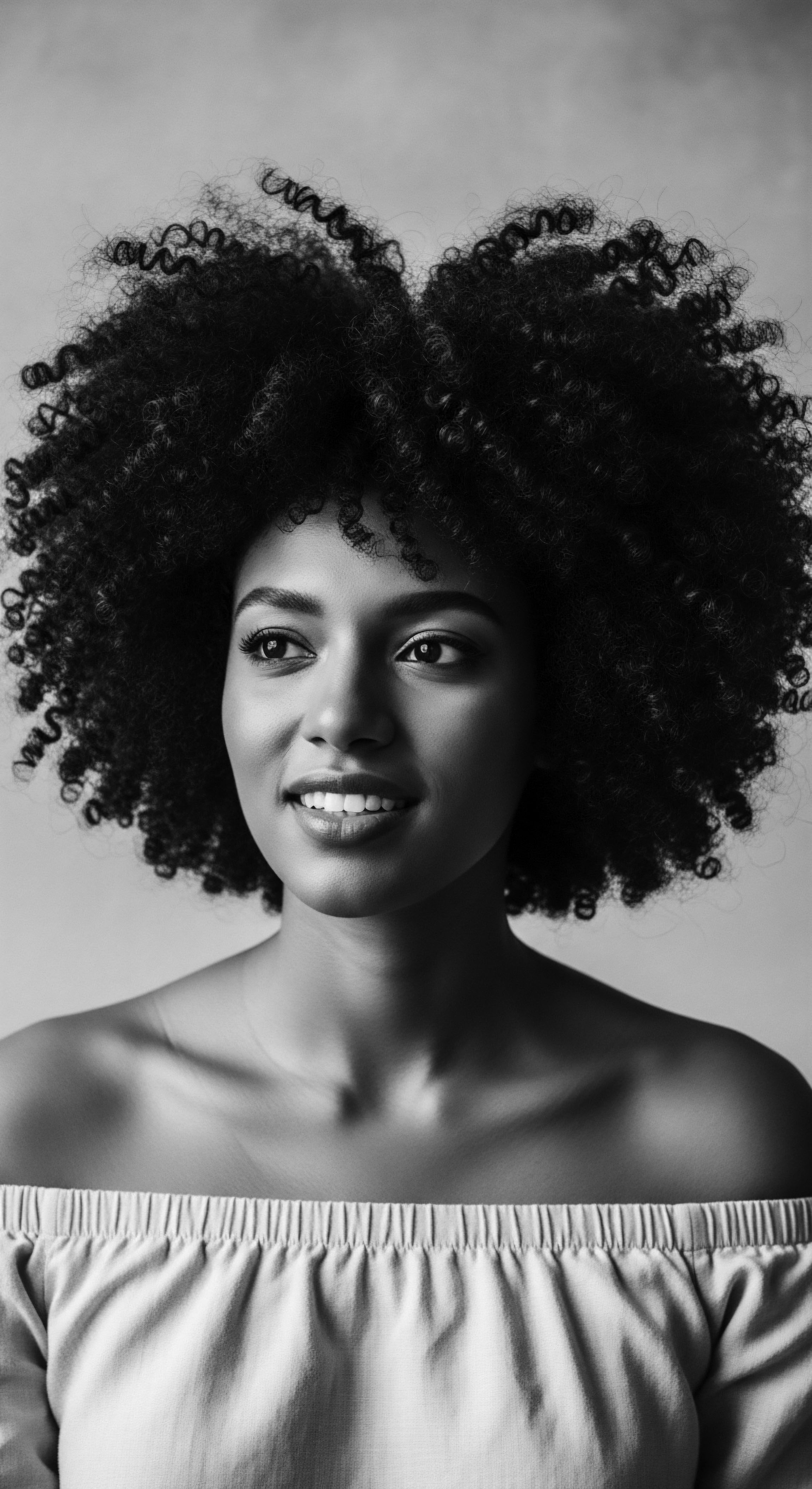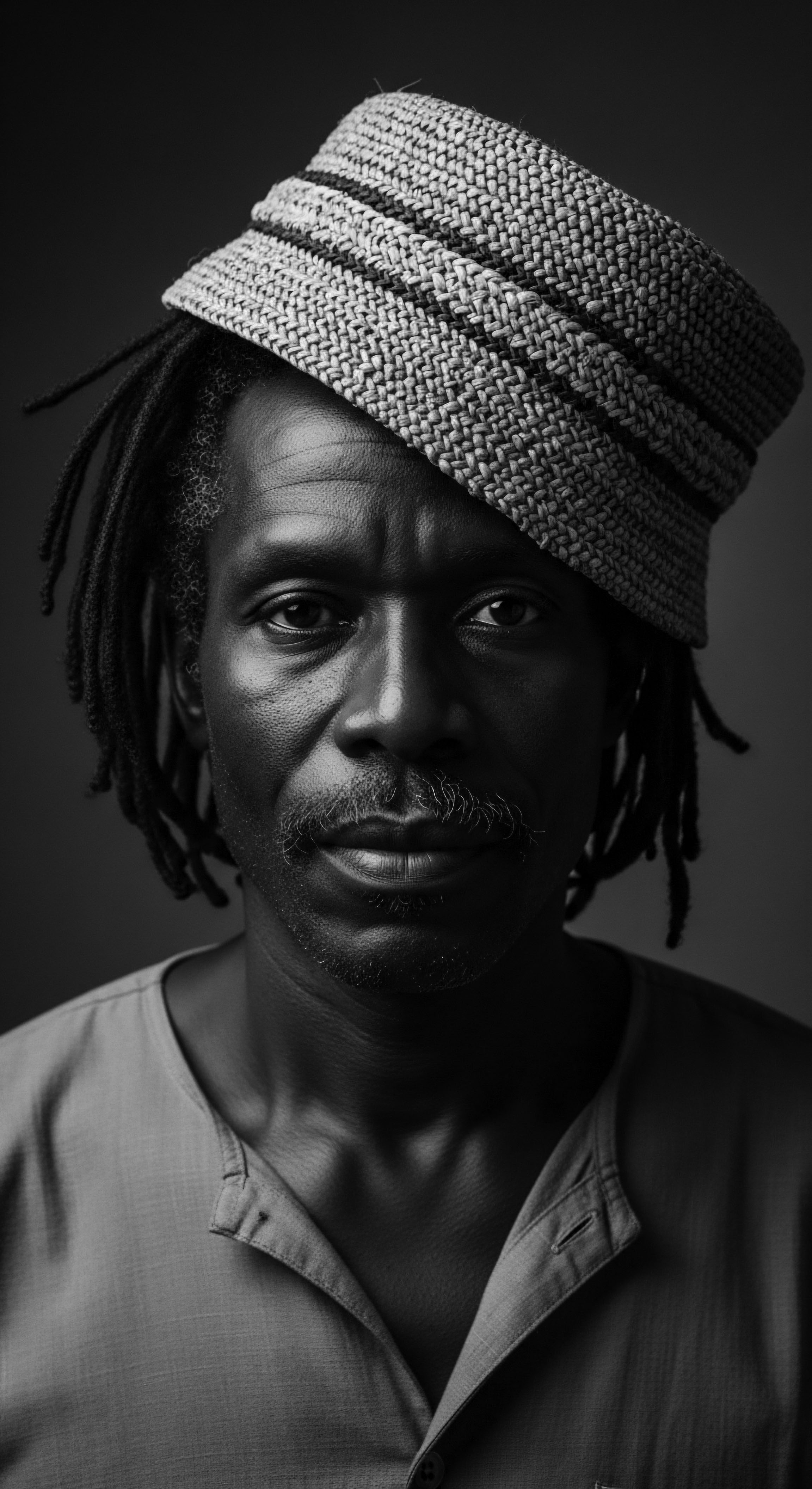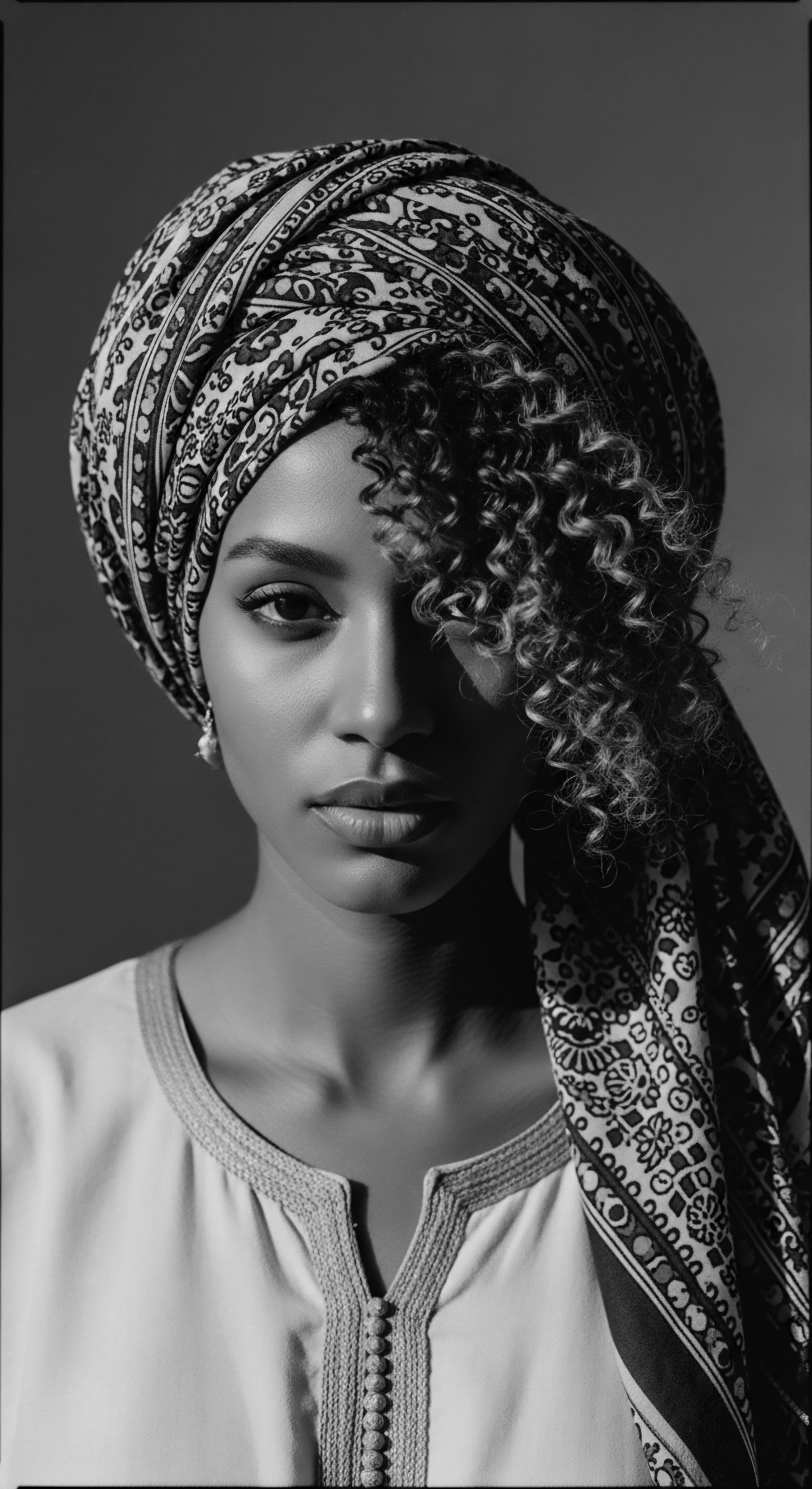
Roots
The quiet rustle of silk or the gentle weight of a satin bonnet at night carries more than just modern utility for those with textured hair. It echoes a profound, long-standing dialogue between our hair and the care it demands, a conversation steeped in ancestral wisdom and the enduring spirit of our lineage. For generations, the crown, whether adorned with intricate braids or simply wrapped, has been a testament to identity, resilience, and a deep, intuitive understanding of preservation. This practice, seemingly simple, holds within its folds a heritage of knowledge passed through hands that understood the delicate nature of textured strands long before scientific terms like “porosity” and “friction damage” entered our shared lexicon.

Hair Anatomy and Ancient Understanding
To truly grasp the long-term benefits of wearing a bonnet, we must first consider the unique architecture of textured hair. Unlike straight hair, which tends to have a smooth, circular cross-section, textured hair often presents with an elliptical or flattened shape, alongside a more complex curl pattern. This structure means the cuticle layers, those outermost protective scales, are not as tightly laid down. Such open cuticles, while allowing for magnificent volume and definition, also render textured hair more prone to moisture loss and mechanical wear.
Historically, communities understood this intrinsic vulnerability. They observed how environmental factors, such as harsh sun or dry air, impacted the hair. Ancient African societies developed practices that instinctively countered these challenges. They did not possess microscopes to visualize the cuticle, yet their methods, including the use of rich natural butters, herbs, and powders, aimed at moisture retention and protection (Creative Support). These ancestral observations laid the groundwork for contemporary hair protection.
The practice of covering textured hair is a living archive, connecting contemporary care with centuries of ancestral wisdom.
Understanding the hair’s very foundation, from follicle to tip, offers a pathway to appreciating the bonnet’s contribution. The human scalp is home to thousands of hair follicles, each an intricate factory producing a strand. Textured hair’s helical growth pattern means strands twist and turn upon themselves, creating points of contact and potential entanglement.
This natural architecture explains why traditional protective styles, and indeed bonnets, became so vital. They recognized that minimizing manipulation was key to maintaining length and strength.

Classifying Textured Hair’s Richness
The modern classification systems for textured hair, while useful, often fall short in capturing the spectrum of types and the cultural nuances intertwined with them. From the tight coils to the broad waves, each pattern has its own distinct requirements and vulnerabilities. Ancestrally, hair classifications were less about numerical types and more about communal identity, social standing, and spiritual connection.
Hair was a form of communication, indicating a person’s age, marital status, wealth, or tribal affiliation (Creative Support, ). The understanding of one’s hair was therefore deeply personal and communal, tied to a lived heritage.
The necessity for protection, whether from environmental elements during arduous labor or simply to preserve the integrity of a carefully constructed style, was a constant across these diverse hair realities. Bonnets, or their precursors in the form of headwraps and scarves, served as a universal acknowledgment of this need. They provided a soft shield, respecting the natural inclinations of the hair.
The vocabulary we use for textured hair has also evolved, bearing the imprint of both scientific discovery and cultural reclamation. Terms like Coily, Kinky, and Wavy describe the morphology, yet within ancestral traditions, the descriptive language often held poetic or symbolic weight. The way a hair was styled, the ornaments adorning it, the fabric that wrapped it, all contributed to a lexicon of selfhood and belonging. The simple act of covering hair at night with a cloth was not merely functional; it was a continuation of this unspoken language of care.

Hair Growth Cycles and Ancestral Nourishment
Hair grows in cycles ❉ anagen (growth), catagen (transition), and telogen (rest) (). This biological rhythm is foundational to hair health. What often disrupts this rhythm, particularly for textured hair, are external stressors ❉ friction, tension, and moisture imbalance. Ancestral communities, lacking contemporary scientific insight, still understood intuitively the rhythms of hair growth.
They fostered healthy environments for their hair through meticulous preparation and application of natural ingredients. Oils and butters extracted from local flora, like shea butter and coconut oil, were used to moisturize and protect hair from harsh conditions (Salford Students’ Union,). These were not just cosmetic applications; they were acts of care rooted in understanding the hair’s need for sustenance and protection.
The bonnet, in its quiet efficacy, joins this ancient chorus of protective practices. It works in concert with the hair’s natural growth cycles by minimizing friction and moisture loss, allowing the hair to rest and thrive unhindered by external aggressors. This synergy between protection and growth reflects a holistic understanding that spans generations.

Ritual
The styling of textured hair has always been more than a mere aesthetic pursuit; it is a ritual, a connection to lineage, a canvas for self-expression, and, quite often, an act of preservation. The bonnet, in its quiet presence, has long been intertwined with these styling traditions, serving as a silent guardian of artistry and effort. From the intricately woven patterns of ancient West Africa to the modern twists and braids of the diaspora, the intention has remained constant ❉ to honor the hair’s natural inclinations and protect its vulnerable structure.

Ancestral Roots of Protective Styling
Protective styles, where hair is tucked away, braided, or twisted to minimize manipulation and environmental exposure, possess deep ancestral roots. The origins of braiding, for example, stretch back to 3500 BC in African cultures (Creative Support, ). These were not simply hairstyles; they were intricate systems of communication, signifying social status, marital status, wealth, and tribal affiliation within various African societies (Creative Support, ). The time spent braiding and styling was also a communal activity, a social bonding ritual (Creative Support, ).
During the transatlantic slave trade, when enslaved individuals were brutally stripped of their identities, cultures, and even their hair, these styling traditions persisted (Creative Support, ). Hair became a defiant symbol of resistance, a hidden language. Some enslaved women reportedly braided rice seeds into their hair as a means of survival, or used intricate cornrow patterns as maps for escape routes (BLAM UK CIC, Salford Students’ Union,). This profound historical context highlights how protective styles, and by extension, the means of preserving them, became intrinsically linked to survival and the upholding of identity in the face of unimaginable oppression.
The bonnet, or head coverings more broadly, served as a vital component in preserving these intricate styles, ensuring their longevity and protecting the hair from the harsh conditions of labor and environment (Hype Hair, ). This heritage of protection is a testament to the ingenuity and resilience of our ancestors.
Bonnets and head coverings have historically shielded intricate styles, preserving both their form and their deep cultural meanings.

Nighttime Guardians and Daily Preservation
The role of the bonnet extends beyond formal styling, touching the very fabric of daily hair care and nightly rituals. It serves as a practical tool for maintaining hairstyles and preventing damage while sleeping (,). When one considers the time and effort invested in styling textured hair, particularly in protective styles like braids, twists, or locs, the need for overnight preservation becomes clear. Without proper protection, hair can become frizzy, tangled, or lose its definition due to friction against rough pillowcases (, ).
This protective function is not a recent discovery. While the modern bonnet, particularly those crafted from silk or satin, offers specific benefits, the principle of covering the hair for protection at night has roots in traditional practices. Headwraps were worn during sleep to protect hair from dust, dirt, and to preserve styles (Wilderness,). The transition from such traditional coverings to the contemporary bonnet reflects an evolving understanding of hair’s vulnerability and the materials best suited to its care.
| Traditional Practices Headwraps/Scarves ❉ Often cotton or locally woven fabrics, used for sun, dust, and style preservation. |
| Modern Bonnet Features Silk/Satin Bonnets ❉ Smooth surface, low absorbency, designed to reduce friction and retain moisture. |
| Traditional Practices Communal Styling ❉ Hair care as a shared, social event, often concluding with protective wraps. |
| Modern Bonnet Features Individualized Care ❉ Focus on personal regimen, though still inspired by communal knowledge. |
| Traditional Practices Natural Materials ❉ Reliance on plant fibers, animal hair, and natural dyes for coverings and adornment. |
| Modern Bonnet Features Engineered Fabrics ❉ Use of specialized materials like mulberry silk or high-grade satin for optimal hair health. |
| Traditional Practices The journey of head coverings for textured hair highlights a continuous quest for preservation, adapting ancestral wisdom to contemporary understanding. |

Tools and Transformations
The toolkit for textured hair care has expanded over time, but some foundational principles remain. Traditional tools, often crafted from natural materials, were designed to gently manage and adorn hair. Combs made from wood, bone, or metal, sometimes even improvised from available materials by enslaved individuals, were essential (Salford Students’ Union,). These tools, alongside natural oils and butters, formed the backbone of a hair care approach that prioritizes gentle handling.
The bonnet, in this context, acts as a complementary tool. It allows the intricate work of styling and conditioning to last longer, reducing the need for frequent manipulation that can lead to breakage. This aligns with the wisdom of protective styling—minimizing disturbance to promote length retention and overall hair health. The smooth surface of a silk or satin bonnet allows hair to glide effortlessly, preventing snagging or tangling that can occur with rougher fabrics like cotton (,).
The connection between bonnets and heat styling is also worth noting. While ancestral methods primarily relied on natural techniques and minimal heat, modern styling often incorporates thermal tools. Bonnets play a counter-balancing role here, helping to preserve straightened or styled hair, thereby reducing the frequency of heat application. This thoughtful preservation acknowledges both modern styling preferences and the timeless need for hair integrity.

Relay
The legacy of textured hair care, particularly the use of head coverings, is not a static relic of the past; it is a living continuum, constantly relaying wisdom from our ancestors to our present-day routines. The bonnet, in this unfolding narrative, stands as a testament to adaptive resilience and deeply ingrained self-care, a practical extension of traditions born of necessity and elevated through cultural meaning. It bridges the gap between historical imperatives and modern scientific understanding, proving its enduring value in promoting the long-term vitality of textured hair.

Personalizing Care Through Ancestral Echoes
Crafting a regimen for textured hair often feels like a modern quest, yet its very foundations rest upon ancestral wisdom. Our forebearers understood the unique requirements of their hair intuitively, drawing upon indigenous knowledge of plants and their properties. They formulated conditioners and treatments from natural elements, creating systems of care tailored to their hair’s specific needs, much like we seek personalized regimens today (Salford Students’ Union,). The bonnet, or protective headwrap, would have been a consistent, practical element in these routines, ensuring that the moisture and benefits of these applications were preserved.
Modern science now validates many of these traditional approaches. The smooth, non-absorbent surfaces of silk and satin bonnets, for instance, are recognized for their ability to retain hair’s natural moisture, unlike cotton which can absorb oils and moisture, leading to dryness and frizz (, ). This scientific explanation provides a contemporary understanding for a practice rooted in generations of observation and lived experience.

The Nighttime Sanctuary and Bonnet Wisdom
The ritual of preparing one’s hair for sleep holds a unique place in the care of textured hair. It transforms the bedchamber into a sanctuary, a space where hair can rest and rejuvenate, protected from the mechanical stresses of tossing and turning. This is where the bonnet truly comes into its own as an indispensable tool.
A significant historical example of head coverings being intertwined with Black and mixed-race experiences, and even becoming a point of societal control, can be found in the Tignon Laws of 1786 in Louisiana. These laws mandated that free women of color in New Orleans wear headscarves, or “tignons,” to publicly distinguish them and ostensibly diminish their beauty and perceived allure in the eyes of white men (JD Institute of Fashion Technology, The Zoe Report, Luxy Hair,). This oppressive decree aimed to strip these women of their self-expression and social standing. Yet, in a remarkable act of defiance and cultural resilience, Black women transformed these restrictive cloths into elaborate, ornate head wraps, using luxurious fabrics and intricate tying styles, turning a symbol of subjugation into a powerful statement of beauty, identity, and resistance (JD Institute of Fashion Technology, Obé Headwear, The Zoe Report, Luxy Hair,).
This historical episode powerfully illuminates how head coverings, including the bonnet’s predecessors, were not only practical protective gear but also potent symbols of heritage, resistance, and the enduring spirit of self-determination. The bonnet today carries this legacy forward, representing an intentional choice to protect and honor one’s hair, reclaiming autonomy over one’s crown.
The scientific understanding of sleep’s impact on hair health further underscores the bonnet’s role. During sleep, the body undergoes cellular renewal, including processes vital for hair growth and scalp health (L’Oréal Paris, DiStefano Hair Restoration Center,). Lack of adequate sleep can lead to increased stress hormones, which may contribute to hair shedding conditions (DiStefano Hair Restoration Center, I2CAN,).
A silk or satin bonnet, by minimizing friction and maintaining moisture, creates an optimal environment that supports the hair’s natural restorative processes during these critical hours (Hype Hair, Silkie, Crowned by Royalty,). It acts as a cocoon, allowing hair to retain length and health by preventing tangles and breakage (Hairlust, NeoCurly, PhiloSophie Hair,).
- Reduced Friction ❉ The smooth surface of silk or satin prevents mechanical damage that cotton pillowcases can inflict, which is particularly relevant for the delicate cuticle of textured hair (, ).
- Moisture Retention ❉ Unlike absorbent fabrics, bonnets made of silk or satin allow hair to retain its natural oils and applied products, combating the dryness that textured hair is often prone to (, ).
- Style Preservation ❉ They help extend the life of hairstyles—from braids to blowouts—reducing the need for frequent manipulation and restyling, thereby minimizing stress on the hair (, ).

Ingredients, Heritage, and Problem Solving
The wisdom of traditional ingredients for textured hair care resonates deeply within the heritage of Black and mixed-race communities. Before the advent of synthetic compounds, ancestral practices relied on the earth’s bounty:
- Shea Butter ❉ A rich emollient, historically used across West Africa for moisturizing and protecting skin and hair (Salford Students’ Union,). Its deep conditioning properties align with the needs of coily hair for intense hydration.
- Coconut Oil ❉ A versatile oil, present in many tropical ancestral diets and beauty rituals, known for its ability to penetrate the hair shaft and reduce protein loss (Salford Students’ Union,).
- Baobab Oil ❉ Extracted from the “Tree of Life,” traditionally used for its nourishing and protective qualities, particularly in regions where the tree thrives (Wilderness,).
These traditional ingredients, often combined with meticulous application and protective styling, including the use of head coverings, laid the groundwork for modern hair care. The bonnet, in its essence, amplifies the benefits of these ingredients by sealing them in. When moisture and nutrients are applied to the hair, a bonnet acts as a barrier, preventing evaporation and allowing the hair more time to absorb the goodness. This continuous absorption is crucial for maintaining hair’s elasticity and preventing breakage.
Addressing common hair problems like breakage, dryness, and frizz also finds a solution in the consistent use of bonnets, a practice rooted in this ancestral understanding of protection. The smooth surface of a bonnet mitigates friction, which is a leading cause of breakage in textured hair (, ). By reducing mechanical stress, bonnets contribute significantly to length retention and overall hair health. This direct correlation between friction reduction and hair integrity is a modern scientific validation of a long-standing cultural practice.
How does the bonnet contribute to hair follicle health over time?
The bonnet’s contribution to hair follicle health is indirect yet meaningful. By creating an environment that minimizes friction and retains moisture, it reduces the overall stress on the hair strand. Less breakage means less strain on the follicle, allowing it to produce healthy strands without constant interruption or damage.
When hair is consistently protected, the scalp environment remains more stable, supporting the natural growth cycle of the hair from its very source. This uninterrupted growth cycle is central to long-term hair health and density.

Reflection
The journey of the bonnet, from utilitarian cloth to a symbol of heritage and health, mirrors the ongoing narrative of textured hair itself ❉ a story of enduring beauty, profound resilience, and the relentless pursuit of holistic well-being. It is a humble garment, yet it carries the whispers of generations, a tangible connection to the hands that once wrapped, braided, and nurtured coils under challenging skies. The “Soul of a Strand” echoes in this simple act of nightly protection, for each strand, shielded and cared for, represents a continuation of a legacy that refused to be diminished.
This exploration reveals that the bonnet is not merely a modern accessory; it is a living artifact of inherited wisdom, a testament to how practical solutions, born from necessity and communal knowledge, become intertwined with identity. It stands as a silent sentinel, guarding the delicate structure of textured hair against the abrasions of the world, much as our ancestors shielded their traditions. In its quiet efficacy, the bonnet ensures that the vitality of our crowns persists, allowing the radiant heritage of textured hair to continue its unbound dance through time. The act of wearing a bonnet is, therefore, a conscious affirmation of self, a nod to the past, and a hopeful gesture toward a future where our hair, in all its varied forms, is celebrated and preserved.

References
- Creative Support. (n.d.). The history of Black Hair.
- DiStefano Hair Restoration Center. (2025, March 7). Does Sleep Affect Hair Health?
- Hairlust. (2025, April 2). The Truth About Silk Bonnets ❉ Why a Bamboo Hair Bonnet is Better.
- Hype Hair. (2023, June 26). Unveiling the History of the Hair Bonnet for Black Women.
- I2CAN. (2024, September 30). The Importance of Sleep for Skin and Hair Health.
- JD Institute of Fashion Technology. (2021, June 23). HEADWRAPS ❉ HISTORY AND EVOLUTION.
- L’Oréal Paris. (2022, August 17). How Does Sleep Affect Hair Health & Growth?
- Luxy Hair. (n.d.). Why headwraps aren’t just a runway accessory.
- NeoCurly. (2023, December 13). Satin Bonnets ❉ Care for Curly, Coily, Braided Hair.
- Obé Headwear. (2024, August 5). Significance of headwraps.
- PhiloSophie Hair. (2024, June 23). The Benefits Of Wearing a Hair Bonnet.
- Salford Students’ Union. (2024, October 29). The Remarkable History Behind Black Hairstyles.
- Silkie. (n.d.). Beauty Sleep is Real ❉ How Better Sleep Leads to Better Hair.
- The Silk Collection. (2025, February 15). Do Silk Bonnets Really Work? Myths vs. Facts.
- The Zoe Report. (2024, February 26). The Silk Bonnet’s History Is Rooted In Black Beauty Rituals.
- Wilderness. (2015, January 25). The history & meaning of head wraps across Africa.
